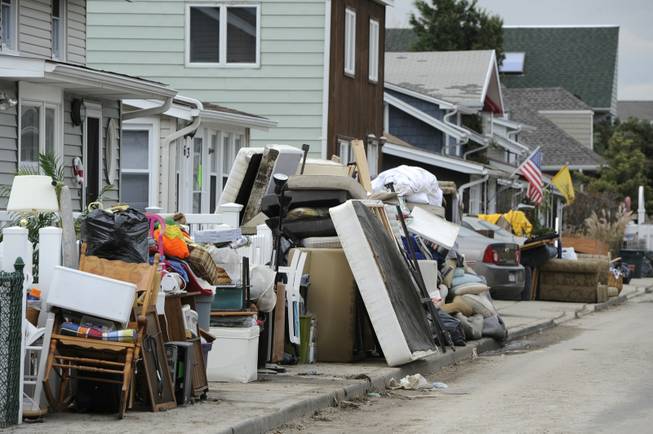
AP
Household items destroyed from flooding from Hurricane Sandy line California Street on Thursday, Nov 1, 2012, in Long Beach, N.Y. Three days after Sandy slammed the mid-Atlantic and the Northeast, New York and New Jersey struggled to get back on their feet, the U.S. death toll climbed to more than 80, and more than 4.6 million homes and businesses were still without power. (AP Photo/Kathy Kmonicek)
Thursday, Nov. 8, 2012 | 1:26 p.m.
NEW YORK — Damage in New York state from Superstorm Sandy could total $33 billion when all is said and done, Gov. Andrew Cuomo said Thursday as the state began cleaning up from a nor'easter that dumped snow, brought down power lines and left hundreds of thousands of new customers in darkness.
A damage forecasting firm had previously estimated that Sandy might have caused $30 billion to $50 billion in economic losses from the Carolinas to Maine, including property damage, lost business and extra living expenses. Cuomo's estimate will likely push the bill even higher.
A damage estimate of even $50 billion total would make Sandy the second most expensive storm in U.S. history, right behind Hurricane Katrina. Sandy inundated parts of New York City and New Jersey with a storm surge as high as 14 feet, killed more than 100 people and left more than 8.5 million people without power at its peak.
Sandy left more people in the dark than any previous storm, the Department of Energy has said, and it left drivers desperate for gas when it complicated fuel deliveries.
"We are going to have to look at a ground-up redesign," Cuomo said of the power and fuel supply systems. "With power outages, you paralyze the nation, and chaos ensues."
In particular, Cuomo noted New York City's problems, largely due to the surge of seawater that inundated utilities lying 15 to 20 stories below ground.
"That's a brilliant engineering masterpiece, yes, but if Manhattan floods, you flood all that infrastructure," he said. "We don't even have a way to pump it out."
After tight gasoline supplies led to long lines and frustration at filling stations, officials in the city and on Long Island said Thursday that rationing will be implemented starting Friday. Drivers will alternate days they can fill up, based on whether their license plates end in an odd or even number.
On Thursday, a nor'easter that stymied recovery efforts from Sandy pulled away from New York and New Jersey, leaving hundreds of thousands of new people in darkness but failing to swamp shorelines anew, as feared.
Residents from Connecticut to Rhode Island saw 3 to 6 inches of snow on Wednesday. Worcester, Mass., had 8 inches of snow, and Freehold, N.J., had just over a foot overnight. Some parts of Connecticut got a foot or more.
From Brooklyn to storm-battered sections of the Jersey shore and Connecticut, about 750,000 customers — more than 200,000 from the new storm — in the region were without power in temperatures near freezing, some after already living for days in the dark.
"We lost power last week, just got it back for a day or two, and now we lost it again," said John Monticello, of Point Pleasant Beach, N.J. "Every day it's the same now: turn on the gas burner for heat. Instant coffee. Use the iPad to find out what's going on in the rest of the world."
Vladimir Repnin, of New York City's Staten Island, emerged from his powerless home with a snow shovel in his hand, a cigarette in his mouth and a question from someone cut off from the outside world.
"Who won? Obama?" he asked.
He didn't like the answer.
"The Democrats ruined my business," he said, referring to his shuttered clothing manufacturing firm.
Unlike other holdouts who got by with generators or gas stoves, the 63-year-old from Ukraine has been without power since Sandy brought 8 feet of water through his door and his neighbor's deck into his yard. He tried to beat the cold Wednesday night by sleeping with his Yorkie, Kuzya, and cat, Channel.
"I had the dog right here," he said, pointing to his left side, "and the cat on my chest. It was still too cold, but I cannot leave my house."
Throughout Staten Island's beach area, the storm had blanketed growing piles of debris with several inches of snow. By mid-morning, it was starting to melt, filling the streets with filthy sludge.
Airlines canceled hundreds of flights before and during the new storm. On Thursday, there were about 600 canceled, according to flight tracking service FlightAware, mostly in the New York area.
But roads in New Jersey and New York City were clear for the morning commute, and rail lines into New York were running smoothly so far, despite snow still coming down heavily in some areas.
The Queens-Midtown Tunnel, a vital vehicular route linking Manhattan to the city borough of Queens and the rest of Long Island, is reopening Friday after being swamped by Sandy, Cuomo said.
Under ordinary circumstances, a storm of this sort wouldn't be a big deal. But large swaths of the landscape were still an open wound, with the electrical system highly fragile and many of Sandy's victims still mucking out their homes and cars and shivering in the deepening cold. As the storm picked up Wednesday evening, lights started flickering off again.
The additional power outages could stall recovery efforts, even though utility companies had prepared, adding extra crews ahead of the nor'easter.
In New Jersey, there were about 400,000 power outages early Thursday; 150,000 of those were new. In New York City and Westchester, more than 70,000 customers were without power after the storm knocked out an additional 55,000 customers.
For Consolidated Edison, the extra outages were dealt with swiftly, so there were only about 3,000 additional customers without power from the total Wednesday of 67,000.
"I think we're going to be able to power through. Our objective was to get power restored to everyone by the weekend and we're still working with that goal," said Alfonso Quiroz, a spokesman for the utility.
Temperatures over the next few days will be in the 50s in southern New England, said meteorologist Frank Nocera, and on Sunday it could edge into the 60s.
Eltman reported from Garden City, N.Y. Contributing to this report were Associated Press writers Kiley Armstrong, Jonathan Fahey, Tom Hays, David B. Caruso, Meghan Barr, Jennifer Peltz and Deepti Hajela in New York; Michael Gormley in Albany, N.Y. Jim Fitzgerald in White Plains, N.Y.; and Angela Del



Join the Discussion:
Check this out for a full explanation of our conversion to the LiveFyre commenting system and instructions on how to sign up for an account.
Full comments policy